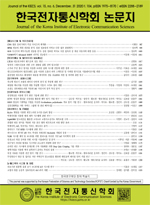위성 자료를 이용한 전선 탐지 기법 연구
Study on the Front Detection Techniques by using Satellite Data
- 한국전자통신학회
- 한국전자통신학회 논문지
- 제15권 제6호
-
2020.121201 - 1208 (8 pages)
-
DOI : 10.13067/JKIECS.2020.15.6.1201
- 33

해양에서 바닷물의 성질이 비슷한 바닷물 덩어리를 수괴라 하며, 전선은 서로 다른 속성의 두 수괴가 만나는 해역이다. 경사도 알고리즘은 해수면 온도 픽셀이 급격하게 변하는 곳을 경사가 크다고 보고, 경사가 큰 곳을 전선으로 가정하여 추출하는 방법이다. 이 방법은 대용량의 위성 자료를 한꺼번에 처리할 수 있다는 장점이 있다. 따라서 본 연구에서는 경사도 알고리즘을 이용하여 한반도 주변 해역의 전선을 찾아보고자 하였다. 연구 자료는 격자화 되어있는 해수면 온도 위성 자료를 이용하였다 해상도는 1/4°이며, 연구 기간은 1993년 1월부터 2018년 12월까지 월 평균 자료를 사용하였다. 해수면 온도 자료를 이용하여 전선 추출 결과 대표적으로 중국 연안 전선(China Coastal Front), 남해 연안 전선(South Sea Coastal Front), 쿠로시오/쿠로시오 속류 전선(Kuroshio Front/ Kuroshio Extension Front), 아극 전선(Subpolar Front), 아북극 전선(Subarctic Front) 등 다섯 개의 전선을 찾을 수 있었다. 계절별 전선 분포 비교 결과 겨울, 봄철에는 여름, 가을철에 비해 더 많은 종류의 전선이 분포하였으며, 분포 범위도 더 넓어졌다.
A mass of seawater with similar properties in the ocean is called a water mass, and the front is a sea area where two masses of different properties meet. The gradient algorithm is a method of extracting where the sea water temperature pixel changes rapidly assuming that the slope is large, and the place with the large slope is assumed to be a front. This method is able to process large amounts of satellite data at once. Therefore, in this study, we tried to find the front lines in the sea area around the Korean Peninsula by using a gradient algorithm. The study data used gridded sea surface temperature satellite data. The resolution was 1/4°, and the monthly average data from January 1993 to December 2018 were used. There were major five fronts representatively, China Coastal Front, South Sea Coastal Front, Kuroshio Front/ Kuroshio Extension Front, Subpolar Front and the Subarctic Front. As a result of comparing the distribution of front by season, more types of front were distributed in winter and spring than in summer and autumn, and the distribution range was wider.
Ⅰ. 서 론
Ⅱ. 자료 및 방법
Ⅲ. 결 과
Ⅳ. 결 론
References
(0)
(0)